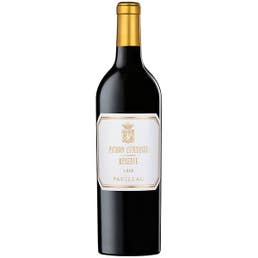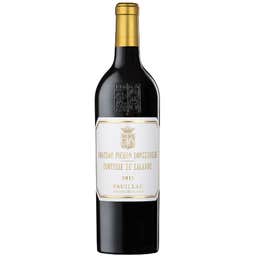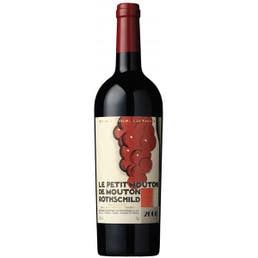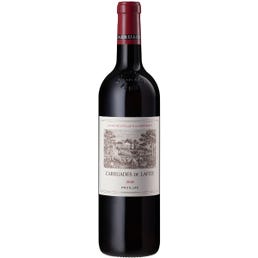Château Pichon Lalande 2018
• Domaine: Château Pichon Longueville Comtesse de Lalande
• Appellation: Pauillac
• Classification: Second Growth, 2ème Grand Cru Classé
• Origin: Left Bank, Bordeaux, France
Many châteaux in Bordeaux are passed down from father to son and run by men, and one often hears winemakers rhapsodize poetically about the union between, “man and vine.” Because of this, the story of Château Pichon Longueville Comtesse de Lalande is a unique and important one. It is a story about feminine influence. The success of this illustrious Super Second is due to the contributions of powerful women who championed it throughout the ages. Because of this, the stunningly voluptuous wines of Château Comtesse de Lalande are drinkable proof that girls do indeed rule.
The origins of the property date back to 1850 when Baron Joseph Pichon Longueville divided his large estate in two upon his death; his male heirs received Château Pichon Longueville au Baron and his daughters received Château Pichon Longueville Comtesse de Lalande. In the 18th Century, the property was run entirely by three women: Therese de Rauzan, Germaine de Laujus and Marie Branda de Terrefort. Though it stood adjacent to the First Growth Château Latour, the wines from Comtesse de Lalande carved out a distinct taste profile from the traditional Pauillac style. They were considered sensual and feminine. After a few years, Virgine, the wife of the Count de Lalande, took over management of the estate. She made many contributions including commissioning the popular architect Duphot to build a residence inspired by the Hotel de Lalande located in Bordeaux. Instead of passing down the estate to male heirs, the estate was passed from aunts to nieces. The female legacy was honored, and the estate remained in the hands of the same family for over 250 years.
In 1978, May-Eliane de Lencquesaing became the new owner and manager of Château Pichon Comtesse de Lalande. She was nicknamed, “Le Générale,” partially because of her husband’s military background and partially because she was a force to be reckoned with. In addition to increasing the size of the property from its original 40 hectares to 89 hectares, she traveled the globe and was a fierce champion of the Bordeaux region. Under her management, quality of the wines skyrocketed, and they earned international recognition and critical acclaim. Eventually, May-Eliane de Lencquesaing sold the estate to Champagne Roderer in 2007. Roderer understood the importance of the feminine influence at Comtesse de Lalande and hired Sylvie Cazes to oversee the property. The estate was renovated and modernized, with a targeted replanting program and a triple tiered gravity-controlled cellar that cost upward of 15 million Euro. This allowed the winemaking team to create softer, more supple wines at the Pauillac estate.
Though less of the grand vin is being made now, the quality continues to improve. With both holdings in Pauillac and Saint-Julien, these 100% organically farmed wines require a bit of time to unfold. They are softer than other Pauillacs but generally require at least 10 to 12 years of bottle ageing to show their sublime secondary characteristics. Their textures are astonishingly silky, and they offer exquisite notes of truffle, dark berry, cassis and cedar. Because of the consistent critical acclaim, this estate would be up for a promotion to a First Growth should a reclassification ever be in the cards.
Tasting Notes
"The 2018 Château Pichon-Longueville Comtesse De Lalande is a monster of a wine with an almost Château Latour-like stature and structure, offering deep, backward, slightly reductive notes of blackcurrants, crushed stone, scorched earth, lead pencil shavings, and tobacco leaf. Based largely on Cabernet Sauvignon mixed with 23% Merlot, 5% Cabernet Franc, and 1% Petit Verdot, it's full-bodied, concentrated, and powerful on the palate, with masses of tannins, beautiful mid-palate density, and a great finish. As I've commented previously, the up-front, sexy style of the past (due to the larger Merlot content, I believe) has been replaced by a more regal, at times austere profile. Nevertheless, it's still its own wine and very Pichon Longueville Comtesse de Lalande in style. This 2018 is going to need 5-7 years of bottle age and will evolve for 40+ years." - Jeb Dunnuck, (3/11/2021), Ratings: 98+, Drink: 2026-2066
"The grand vin represents 50% of the crop this year. The 2018 Pichon Longueville Comtesse de Lalande is made up of 71% Cabernet Sauvignon, 23% Merlot, 5% Cabernet Franc and 1% Petit Verdot with a pH of 3.85, an IPT (total polyphenol index) of 87 and 14% alcohol. Very deep purple-black colored, it is like hitting a brick wall to begin, needing considerable coaxing to start to reveal notes of crushed black cherries, warm blackberries, ripe blackcurrants and chocolate cake with nuances of violets, rose hip tea, charcuterie, tapenade and incense with wafts of new leather and iron ore. Full-bodied, concentrated and completely laden with tightly wound black fruit and savory layers, the palate gives a rock-solid backbone of firm, super ripe, super fine-grained tannins and soft background freshness, finishing very long with a veritable display of mineral fireworks." - Lisa Perrotti-Brown, Robert Parker's Wine Advocate (4/23/2019, Bordeaux 2018 Issue), Ratings: 97-99
"The 2018 Pichon-Lalande was given an hour’s decant and then observed over the next 24 hours. It has clearly retained the showstopping nose that I encountered from barrel, those same “gentle waves" of black cherries and blueberry, incense and violets lending it a Margaux-like allure. The palate is vibrant and full of tension from the start, the acidity slicing through the layers of quite plush black fruit, judiciously laced with tobacco and mint. There is a beguiling sense of harmony conveyed by this Pichon-Lalande and although there is clearly plenty of structure, the tannins are so pixelated and pliant that it might well be broachable in 4–5 years’ time. Personally, however, I would prefer to cellar it for 8–10 years (by which time I hope that the new Cure album is finally released). However long you decide to keep it tucked away, this is a quite brilliant Pauillac." - Neal Martin, vinous (3/2021), Ratings: 97, Drink: 2025-2055
| LWIN | 2179511 |
|---|---|
| Stock Status | In Stock |
| Appellation | Pauillac |
| Vintage | 2018 |
| Brand | Château Pichon Lalande |
| Shipping Weight | 3.000000 |













